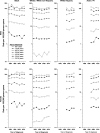Pancreatic cancer incidence trends: evidence from the Surveillance, Epidemiology and End Results (SEER) population-based data
- PMID: 29149259
- PMCID: PMC5913617
- DOI: 10.1093/ije/dyx232
Pancreatic cancer incidence trends: evidence from the Surveillance, Epidemiology and End Results (SEER) population-based data
Abstract
Background: Annual pancreatic cancer incidence rates have been increasing. We examine pancreatic cancer incidence trends by demographics and histologic type.
Methods: Data from the Surveillance, Epidemiology and End Results (SEER) registries were available to assess temporal trends and pancreatic cancer rates from 1974 to 2013.
Results: Pancreatic cancer incidence rates declined between the 1970s and 1990s but increased from 1994 to 2013 among White males. Among non-Hispanic White and Hispanic males, the annual percent change (APC) in incidence between 1992 and 2013 was 0.84% and 0.73%, respectively. Rates also rose among White non-Hispanic, Hispanic and Asian females (APC = 0.81%, 0.56% and 1.23%, respectively) and even more rapidly among females aged 25-34 years (APC > 2.5%). Rates among Black males and females remained unchanged, but higher compared with the other racial/ethnic groups. By histologic type, the increases were greatest for non-secretory endocrine cancers ( > 6%), followed by ductal adenocarcinomas (∼5%) and adenocarcinoma, NOS (∼1.4%)-the largest histologic subgroup of pancreatic cancer. Rates for mucinous adenocarcinomas and poorly specified pancreatic cancer decreased. Overall, incidence rates during 2000-13 were higher among males than females [MF incidence rate ratio (IRR) = 1.28]. The IRR was >1.00 at all ages ≥ 35, but rates among females were higher at younger ages (IRRs 15-24: 0.66, 25-34: 0.81). The MF IRRs for most of the histologic types were elevated among males apart from solid pseudopapillary adenocarcinoma and cystic carcinomas (IRR = 0.22, confidence interval: 0.14-0.34 and 0.52, 0.41-0.65, respectively).
Conclusion: Pancreatic cancer has been increasing overall, but patterns differ by demographic group and histologic type. Many of the trends parallel changing prevalence of lifestyle risk factors such as smoking, overweight and obesity, and diabetes in the USA, particularly for pancreatic adenocarcinoma, and improved diagnosis methods during the past 40 years.
Figures



References
-
- Howlader N, Noone A-M, Krapcho M, et al. SEER Cancer Statistics Review, 1975–2014. Bethesda: National Cancer Institute, 2017.
-
- Rahib L, Smith BD, Aizenberg R, et al. Projecting cancer incidence and deaths to 2030: the unexpected burden of thyroid, liver, and pancreas cancers in the United States. Cancer Res 2014. http://cancerres.aacrjournals.org/content/74/11/2913.long (11 March 2017, date last accessed). - PubMed
-
- American Cancer Society. Cancer Facts & Figures 2016. Atlanta, GA: American Cancer Society, 2016.
-
- Kamisawa T, Wood LD, Itoi T, et al. Pancreatic cancer. Lancet Lond Engl 2016;388:73–85. - PubMed
-
- Siegel RL, Miller KD, Jemal A. Cancer statistics, 2016. CA Cancer J Clin 2016;66:7–30. - PubMed
Publication types
MeSH terms
LinkOut - more resources
Full Text Sources
Other Literature Sources
Medical
Miscellaneous

